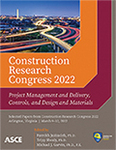Estimating Electricity Consumption of Buildings Using Information Theory and Machine Learning Methods
Publication: Construction Research Congress 2022
ABSTRACT
Estimating electricity consumption of buildings is an essential task in building energy management to enable decision makers to compare different energy efficiency measures and control strategies. With the growth in available building energy data, many opportunities have been emerged to apply Machine Learning (ML) methods for prediction of building energy performance. The objective of this paper is to (1) analyze and evaluate the influence of different building features on electricity consumption, and (2) evaluate the predictive performance of different ML methods in estimating electricity consumption of buildings with various occupancy types, surface area, locations, and climates. To this end, feature importance assessment is performed using Mutual Information (MI) from information theory. Moreover, four frequently used ML methods, including decision tree, random forest, multilayer perceptron, and gradient boosting are implemented to predict building electricity consumption using the latest version of Commercial Buildings Energy Consumption Survey (CBECS) data. The primary contributions that this research adds to the body of knowledge are (1) the application of information theory to evaluate the influence of different building features on electricity consumption, and (2) the development of new ML models to predict electricity consumption of buildings with different characteristics such as occupancy, surface area, location, and climate. Based on MI analysis square footage, number of employees, cooling equipment type, and principal building activity had the highest influence on building total electricity consumption. Moreover, random forest had the best performance with the coefficient of determination of 0.79 among other ML methods.
Get full access to this article
View all available purchase options and get full access to this chapter.
REFERENCES
Abdallah, M., and El-Rayes, K. (2016). “Multiobjective Optimization Model for Maximizing Sustainability of Existing Buildings.” Journal of Management in Engineering, 32(4), 04016003.
Abediniangerabi, B., Makhmalbaf, A., and Shahandashti, M. (2021). “Deep learning for estimating energy savings of early-stage facade design decisions.” Energy and AI, Elsevier Ltd, 5, 100077.
Ascione, F., Bianco, N., Iovane, T., Mauro, G. M., Napolitano, D. F., Ruggiano, A., and Viscido, L. (2020). “A real industrial building: Modeling, calibration and Pareto optimization of energy retrofit.” Journal of Building Engineering, Elsevier Ltd, 29(December 2019), 101186.
EIA (Energy Information Adminstration). (2012). 2012 Commercial Buildings Energy Consumption Survey. Energy Information Adminstration.
Hutchison, S., Ghafoori, M., Abdallah, M., and Clevenger, C. (2019). “Optimizing selection of building materials and fixtures to reduce operational costs.” Proceedings, Annual Conference - Canadian Society for Civil Engineering.
Iguyon, I., and Elisseeff, A. (2003). “An introduction to variable and feature selection.” Journal of Machine Learning Research.
Kaskhedikar, A., Reddy, T. A., and Runger, G. (2015). “Use of random forest algorithm to evaluate model-based EUI benchmarks from CBECS database.” ASHRAE Conference-Papers, 121, 17–28.
Kraskov, A., Stögbauer, H., and Grassberger, P. (2004). “Estimating mutual information.” Physical Review E - Statistical Physics, Plasmas, Fluids, and Related Interdisciplinary Topics, 69(6), 16.
Li, Q., Meng, Q., Cai, J., Yoshino, H., and Mochida, A. (2009). “Applying support vector machine to predict hourly cooling load in the building.” Applied Energy, Elsevier Ltd, 86(10), 2249–2256.
Melek, Y., and Aytun, O. U. (2007). “An energy benchmarking model based on artificial neural network method utilizing US Commercial Buildings Energy Consumption Survey (CBECS) database.” International journal of energy research, 31(August 2007).
Neto, A. H., and Fiorelli, F. A. S. (2008). “Comparison between detailed model simulation and artificial neural network for forecasting building energy consumption.” Energy and Buildings, 40(12), 2169–2176.
Nguyen, A. T., Reiter, S., and Rigo, P. (2014). “A review on simulation-based optimization methods applied to building performance analysis.” Applied Energy, Elsevier Ltd, 113, 1043–1058.
Papana, A., and Kugiumtzis, D. (2008). Evaluation of mutual information estimators on nonlinear dynamic systems.
Robinson, C., Dilkina, B., Hubbs, J., Zhang, W., Guhathakurta, S., Brown, M. A., and Pendyala, R. M. (2017). “Machine learning approaches for estimating commercial building energy consumption.” Applied Energy, 208(August), 889–904.
Ross, B. C. (2014). “Mutual information between discrete and continuous data sets.” PLoS ONE, 9(2).
Suzuki, T., Sugiyama, M., Sese, J., and Kanamori, T. (2008). “New challenges for feature selection Approximating Mutual Information by Maximum Likelihood Density Ratio Estimation.” JMLR: Workshop and Conference Proceedings, 4(1), 5–20.
Tso, G. K. F., and Yau, K. K. W. (2007). “Predicting electricity energy consumption: A comparison of regression analysis, decision tree and neural networks.” Energy, 32(9), 1761–1768.
Information & Authors
Information
Published In
History
Published online: Mar 7, 2022
Authors
Metrics & Citations
Metrics
Citations
Download citation
If you have the appropriate software installed, you can download article citation data to the citation manager of your choice. Simply select your manager software from the list below and click Download.
